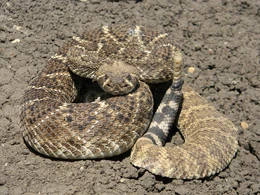
The Western Diamondback Rattlesnake is a venomous pit viper that commonly grows around 4 feet in length. However, these snakes can reach lengths of up to seven feet which makes it the largest of the Southwestern desert rattlesnakes. They have a triangular shaped head with two dark diagonal lines on each side of their face running from their eyes to their jaws. Their name is derived from the dark diamond-shaped patterns along their back. Their tail has black and white bands just above the rattles. This coloration is more easily visible on young snakes but is faded on older snakes.
The iconic rattle at the end of the Rattlesnake’s tail is made up of a hardened protein called “keratin,” the same protein that forms human hair and fingernails. A new segment is added to the rattle each time the snake sheds its skin. However, due to varying rates of shedding and the fact that segments regularly break off, the size of the rattle does not reflect the snake’s age. Rattlesnakes will use their rattle to warn that they feel threatened and may be about to strike.
During breeding season in the spring, the male rattlesnakes will compete for the females by “wrestling” each other. The gestation period lasts for about 167 days and the mother will then give birth to a brood of about 14. The young rattlesnakes are fully developed when born, and thus already have a venomous bite. After only about 2 hours, the mother will leave the young. They will then have to fend for themselves in search of food and shelter for the coming winter.
Behavior[]
C. atrox is solitary except during the mating season. Usually inactive between late October and early March, these ectotherms occasionally may be seen basking in the sun on warm winter days. In the winter, they hibernate or brumate in caves or burrows, sometimes with many other species of snakes. Life expectancy is more than 20 years.
They are poor climbers. Natural predators include raptors such as hawks and eagles, roadrunners, wild hogs, and other snakes. When threatened, they usually coil and rattle to warn aggressors. They are one of the more aggressive rattlesnake species in the US in the way that they stand their ground when confronted by a foe. If rattling does not work, then the snake will strike in defense.
Habitat[]
The Diamondback’s range includes the entire southwestern U.S. and northern half of Mexico. They enjoy territories such as deserts, plains, rocky regions, and forests.
Diet[]
Rattlesnakes prefer to hunt at night, feeding mainly on rodents and small mammals. The snake’s favorites include mice, rabbits, and lizards.
The snake bites its prey to inject venom. At times, the snake’s teeth will stay in the animal. However, a snake is capable of replacing its teeth if it loses them. After the victim is dead, the snake will swallow it whole. It will digest as it passes through the body. The rattlesnake is very persevering, capable of surviving up to two years without eating!
Venom[]
Like most other American pit vipers, the venom contains proteolytic enzymes. Proteolytic venoms are concentrated secretions that destroy tissues as a result of catabolism of structural and other proteins, which help in disabling prey. The venom of C. atrox is primarily hemotoxic, affecting mainly the blood vessels, blood cells and the heart. The venom contains hemorrhagic components called zinc metalloproteinases. The venom also contains cytotoxinsand myotoxins which destroy cells and muscles that add to the failure of the cardiovascular system. In addition to hemorrhage, venom metalloproteinases induce myonecrosis (skeletal muscle damage), which seems to be secondary to the ischemia that ensues in muscle tissue as a consequence of bleeding and reduced perfusion. Microvascular disruption by metalloproteinases also impairs skeletal muscle regeneration, being therefore responsible for fibrosis and permanent tissue loss after bites from this species. General local effects include pain, heavy internal bleeding, severe swelling, severe muscle damage, bruising, blistering, and necrosis; systemic effects are variable and not specific, but may include headache, nausea, vomiting, abdominal pain, diarrhea, dizziness, and convulsions. Hemorrhagins causing bleeding is a major clinical effect.
This species has LD values of 2.72 mg/kg intravenous, 20 mg/kg intramuscular and 18.5 mg/kg subcutaneous, which is far less toxic than many other rattlesnakes. However, because of its large venom glands and specialized fangs, the western diamondback rattlesnake can deliver a significant amount of venom in a single bite. The average venom yield per bite is usually between 250 and 350 mg, with a maximum of 700–800 mg. Severe envenomation is rare, but possible, and can be lethal. Mortality rate of untreated bites is between 10 and 20%.
Reproduction[]
Rattlesnakes, including C. atrox, are viviparous. Gestation lasts six or seven months, and broods average about a dozen young. However, the young only stay with the mother for a few hours before they set off on their own to hunt and find cover, thus the mortality rate is very high. Mating occurs in the fall, and the females give birth to as many as 25 young, which may be as long as 30 cm (12 in). The young are fully capable of delivering a venomous bite from the moment they are born.